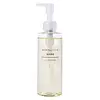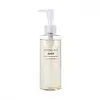What's inside
What's inside
 Key Ingredients
Key Ingredients

 Benefits
Benefits

 Concerns
Concerns

 Ingredients Side-by-side
Ingredients Side-by-side

Hydrogenated Polyisobutene
EmollientCoconut Oil Polyglyceryl-6 Esters
EmollientEthyl Oleate
EmollientSorbitan Oleate
EmulsifyingOlea Europaea Fruit Oil
MaskingSimmondsia Chinensis Seed Oil
EmollientHelianthus Annuus Seed Oil
EmollientDipropylene Glycol
HumectantCitrus Aurantium Amara Flower Water
MaskingPolyquaternium-51
Skin ConditioningPrunus Persica Leaf Extract
EmollientMalt Juice
Skin ConditioningSodium Hyaluronate
HumectantGlycerin
HumectantButylene Glycol
HumectantTocopherol
AntioxidantPhenoxyethanol
PreservativeMethylparaben
PreservativeHydrogenated Polyisobutene, Coconut Oil Polyglyceryl-6 Esters, Ethyl Oleate, Sorbitan Oleate, Olea Europaea Fruit Oil, Simmondsia Chinensis Seed Oil, Helianthus Annuus Seed Oil, Dipropylene Glycol, Citrus Aurantium Amara Flower Water, Polyquaternium-51, Prunus Persica Leaf Extract, Malt Juice, Sodium Hyaluronate, Glycerin, Butylene Glycol, Tocopherol, Phenoxyethanol, Methylparaben
Olea Europaea Fruit Oil
MaskingEthylhexyl Palmitate
EmollientSorbeth-30 Tetraoleate
EmulsifyingPolysorbate 80
EmulsifyingSorbitan Oleate
EmulsifyingWater
Skin ConditioningPentylene Glycol
Skin ConditioningTocopherol
AntioxidantGlycosyl Trehalose
Emulsion StabilisingButylene Glycol
HumectantHydrogenated Starch Hydrolysate
HumectantGlycerin
HumectantPolyquaternium-51
Skin ConditioningCitrus Grandis Seed Extract
AstringentPortulaca Oleracea Extract
Skin Conditioning
 Reviews
Reviews

Ingredients Explained
These ingredients are found in both products.
Ingredients higher up in an ingredient list are typically present in a larger amount.
Butylene Glycol (or BG) is used within cosmetic products for a few different reasons:
Overall, Butylene Glycol is a safe and well-rounded ingredient that works well with other ingredients.
Though this ingredient works well with most skin types, some people with sensitive skin may experience a reaction such as allergic rashes, closed comedones, or itchiness.
Learn more about Butylene GlycolGlycerin is already naturally found in your skin. It helps moisturize and protect your skin.
A study from 2016 found glycerin to be more effective as a humectant than AHAs and hyaluronic acid.
As a humectant, it helps the skin stay hydrated by pulling moisture to your skin. The low molecular weight of glycerin allows it to pull moisture into the deeper layers of your skin.
Hydrated skin improves your skin barrier; Your skin barrier helps protect against irritants and bacteria.
Glycerin has also been found to have antimicrobial and antiviral properties. Due to these properties, glycerin is often used in wound and burn treatments.
In cosmetics, glycerin is usually derived from plants such as soybean or palm. However, it can also be sourced from animals, such as tallow or animal fat.
This ingredient is organic, colorless, odorless, and non-toxic.
Glycerin is the name for this ingredient in American English. British English uses Glycerol/Glycerine.
Learn more about GlycerinOlea Europaea Fruit Oil is the fixed oil obtained from the ripe fruit of the Olive. In other words - olive oil.
The primary contents of olive oil are glycerides of the fatty acids linoleic, oleic and palmitic.
Olive oil also contains antioxidants such as Vitamin E. Antioxidants may help reduce signs of aging by fighting unstable free-radical molecules. It also contains Vitamins A (retinol), D, and K.
The squalene in olive oil makes it a great emollient. Emollients help soothe and soften your skin by trapping moisture in. This makes olive oil a great skin moisturizer.
Studies show olive oil to have antibacterial and antifungal properties in low concentrations. Another study found olive oil irritated sensitive oily skin. We always recommend speaking with a professional about using this ingredient in your routine.
Due to the fatty acid content, this ingredient may not be fungal-acne safe.
Learn more about Olea Europaea Fruit OilPolyquaternium-51 is a polymer salt. It helps hydrate the skin by creating a film on top. This film traps moisture in, keeping your skin soft and hydrated.
Sorbitan Oleate is created from compounds in oleic acid and sorbitol.
It is used to stabilize a product by preventing ingredients from separating. Emulsifiers help keep ingredients together, such as oils and water.
According to a manufacturer, the ingredient Sorbitan Monooleate shares an INCI name with this one.
Sorbitan Oleate may not be fungal acne safe. It can also worsen oily skin.
Learn more about Sorbitan OleateTocopherol (also known as Vitamin E) is a common antioxidant used to help protect the skin from free-radicals and strengthen the skin barrier. It's also fat soluble - this means our skin is great at absorbing it.
Vitamin E also helps keep your natural skin lipids healthy. Your lipid skin barrier naturally consists of lipids, ceramides, and fatty acids. Vitamin E offers extra protection for your skin’s lipid barrier, keeping your skin healthy and nourished.
Another benefit is a bit of UV protection. Vitamin E helps reduce the damage caused by UVB rays. (It should not replace your sunscreen). Combining it with Vitamin C can decrease sunburned cells and hyperpigmentation after UV exposure.
You might have noticed Vitamin E + C often paired together. This is because it is great at stabilizing Vitamin C. Using the two together helps increase the effectiveness of both ingredients.
There are often claims that Vitamin E can reduce/prevent scarring, but these claims haven't been confirmed by scientific research.
Learn more about Tocopherol